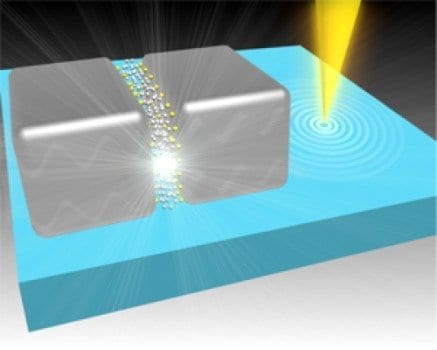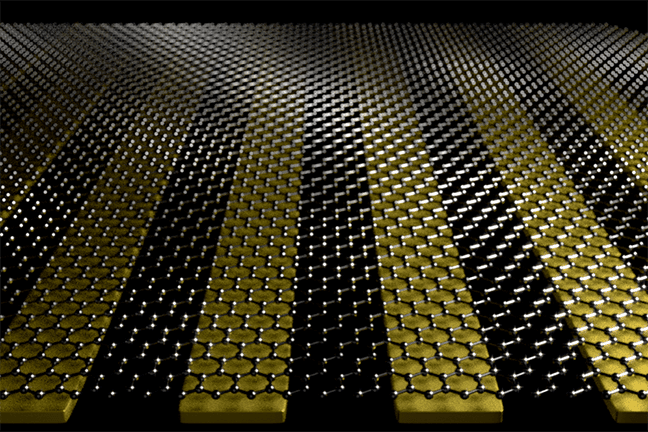
Two-dimensional materials bring quantum-mechanical effects into the macroscopic world, creating the potential for electronic devices which dissipate very little energy
Sense and superfluidity
At the atomic and molecular scales, the world can be a very strange place, with everyday notions of temperature, energy and physical coherence thrown into disarray. With reality at the quantum level we must talk of statistical likelihood and probability rather than simple billiard ball cause and effect.
Take the concept of superfluidity, an ultra-cold state in which matter acts as a fluid with zero viscosity. You can think of superfluidity as a generalised thermodynamic analogue of the more commonly understood electrical superconductivity, whereby electrons move through materials without resistance and energy loss.
Bose-Einstein condensation in graphene
Superfluidity was first discovered in liquid helium, at temperatures of just a few degrees above absolute zero, but the phenomenon is evident at scales ranging from the atomic to the cosmic. It is related to the state of matter known as a Bose-Einstein condensate, in which a large fraction of the particles in bulk matter occupy the lowest quantum energy state. The particles, which at higher temperatures move around in a random, haphazard fashion, can in this way behave as a coherent or at least quasi-coherent whole, thus bringing quantum-mechanical effects into macroscopic visibility.
Fascinating if somewhat esoteric physics it may be, but there is a practical side to superfluidity and Bose-Einstein condensation. For one thing it has implications for the behaviour of electronic devices, albeit specialist ones operating at ultra-low temperatures. To this end a group of researchers associated with Europe’s Graphene Flagship have investigated the properties of electrons moving in two-dimensional structures formed from graphene and gallium arsenide.
Graphene and Coulomb drag
Graphene is crystalline carbon arranged in transparent, single atom-thick layers, with the carbon atoms set in a honeycomb-like lattice. The best known of the hundreds of two-dimensional materials discovered to date, graphene has a number of unique electrical, mechanical and other properties that give it huge potential for applications ranging from electronics to super-strong structures.
Read more: Graphene brings quantum effects to electronic circuits
The Latest on: Quantum effect
[google_news title=”” keyword=”quantum effect” num_posts=”10″ blurb_length=”0″ show_thumb=”left”]
via Google News
The Latest on: Quantum effect
- Quantum Breakthrough: Researchers Unlock New Realms in 1D Superconductivityon April 27, 2024 at 7:14 am
Researchers at the University of Manchester have made a major advancement in superconductivity by successfully maintaining robust superconductivity under high magnetic fields in a new one-dimensional ...
- Scientists Uncover Surprising Reversal in Quantum Systemson April 26, 2024 at 12:13 pm
Generally, it's advised not to compare apples to oranges. However, in the field of topology, a branch of mathematics, this comparison is necessary. Apples and oranges, it turns out, are said to be ...
- The end of the quantum tunnel: Exact instanton transseries for quantum mechanicson April 26, 2024 at 10:46 am
In the quantum world, processes can be separated into two distinct classes. One class, that of the so-called "perturbative" phenomena, is relatively easy to detect, both in an experiment and in a ...
- Q-day approaching: Can Ethereum survive a quantum emergency?on April 26, 2024 at 7:15 am
Ethereum seems to have established an emergency protocol to survive if a quantum emergency is detected. However, the emergency solution has serious caveats, which should make the Ethereum developer ...
- Quantum mechanical wormholes fill gaps in black hole entropyon April 25, 2024 at 4:58 am
A new theoretical model could solve a 50-year-old puzzle on the entropy of black holes. Developed by physicists in the US, Belgium and Argentina, the model uses the concept of quantum-mechanical ...
- Quantum forces used to automatically assemble tiny deviceon April 25, 2024 at 1:48 am
The very weak forces of attraction caused by the Casimir effect can now be used to manipulate microscopic gold flakes and turn them into a light-trapping tool ...
- Gold owes its 'glow' and luminescence to the quantum realmon April 24, 2024 at 1:28 pm
New research reveals luminescence and quantum effects in thick gold films, enhancing understanding and opening doors for energy solutions.
- Tunable quantum anomalous Hall effects in van der Waals heterostructureson April 23, 2024 at 1:01 am
The quantum anomalous Hall effect (QAHE) has unique advantages in topotronic applications, but realizing the QAHE with tunable magnetic and topological properties for building functional devices is ...
- Comprehensive model unravels quantum-mechanical effects behind photoluminescence in thin gold filmson April 19, 2024 at 5:32 am
EPFL researchers have developed the first comprehensive model of the quantum-mechanical effects behind photoluminescence in thin gold films; a discovery that could drive the development of solar fuels ...
- Quantum Barkhausen noise detected for the first timeon April 19, 2024 at 1:30 am
Researchers in the US and Canada have detected an effect known as quantum Barkhausen noise for the first time. The effect, which comes about thanks to the cooperative quantum tunnelling of a huge ...
via Bing News










